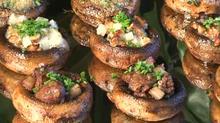A DIFFERENT PERSPECTIVE
Judith and Phil Morse already had taken a wild food tour at the suggestion of a friend before they visited the market in Carrboro. They did not feel confident enough
 in their knowledge of what was edible to forage for dinner, but they were getting closer.
in their knowledge of what was edible to forage for dinner, but they were getting closer."You really do get tuned into the plant world," said Phil Morse, 69, who lives in a nearby rural county. "It's really given us a different perspective about food."
Alan Muskat, a longtime forager who is organizing the Asheville market, said eating wild foods was not only cheap and healthy but good for the environment.
"It really takes on the whole idea of agriculture, which is so foundational to the way we think about food," he said.
Cornell University ecologist Antonio DiTommaso said he was encouraged by the growing interest in eating wild plants and thinks the trend could affect which crops are grown. He no longer buys lettuce in the summer, he said, choosing instead to eat a mixture of plants from his yard in upstate New York.
He wondered how far the movement could go in supplanting traditional agriculture.
"It might have been okay 10,000 years ago," said DiTommaso, an assistant professor in the crop and soil sciences department. "If we get all of New York City running through our fields in upstate New York, I don't know that there would be much left."
Muskat, who studied philosophy and ecology at Princeton University, said he sold foraged mushrooms to high-end restaurants for more than 15 years, often selling more than 500 pounds of them a year at prices of $12 to $40 a pound.
Foragers have met sporadic resistance, usually due to concerns that rare plants and mushrooms will be over harvested.
Many public parks prohibit or at least restrict foraging. New York City parks adopted a non-foraging stance after noting an uptick in the number of people doing it there.
The national parks make exceptions for certain abundant foods, such as cactus pears in Arizona's Casa Grande Ruins National Monument and berries at Cape Cod National Seashore. But even in those cases, the food can be taken solely for personal use, not for sale.
On a recent walk, Muskat was careful to pick only small pieces of a ginger-like root, leaving plenty to keep growing. He insists foraging is good for the long-term health of natural areas.
"Foraging makes the woods more valuable," Muskat said. "And when something has value, you protect it."





